MONSTER EAR TRUMPETS FOR AIR DEFENCE
During the last years of the Great War, sound detectors played an increasingly important part in the air defences of all the belligerents. Since those days they have undergone great development. Here the emperor of Japan is inspecting the huge trumpet-like detectors that work in conjunction with the anti-aircraft guns (seen right)
This last in a series on ‘Things of tomorrow’ draws upon Boyd Cable, ‘Future schemes of air defence’, in John Hammerton, ed., War in the Air: Aerial Wonders of our Time (London: Amalgamated Press, n.d. [1936]), 310-6. (There was a seventh in the series, but by another author and on a non-military subject, that of stratospheric flight.) The previous posts looked at ‘Death from the skies’, ‘The doom of cities’, ‘New horrors of air attack’, ‘If war should come’ and ‘When war does come: terrifying effects of gas attacks’.
Cable starts off a little defensively, allowing that ‘it may have seemed to some readers that I have been unduly gloomy and pessimistic’ in his previous articles about the threat of aerial bombardment. He doesn’t think so, but here presents ‘the other side of the picture’. Even so he immediately argues that the problem of defence is made more difficult by the development of blind flying at night or in bad weather ‘by means of his compass and various stabilizing and automatic steering instruments’. Also,
we know it is a commonplace of commercial air routes that by wireless he can, if he is unaware of his position, communicate with his base station, and within a matter of seconds he can be told the exact spot over which he is flying […] so far no experiments have succeeded in effectively “jamming” or “mixing” a pilot’s questions and answers.
He does however note that, especially in war conditions, such flying demands high skilled pilots, and ‘Casualties in the first days of intensive air raiding could not but be heavy, and those highly skilled pilots would soon be reduced in numbers’. Interceptor pilots would also take losses, but these are easier to train than bomber pilots.
Cable suggests that while Britain’s island nature is disadvantageous because bombers can approach over the sea undetected, it is less of a problem than in the last war:
We have now, for instance, what we had not then, flying boats able to keep in the air or on the sea for days, so that now they can establish patrols and a chain of listening posts far out to sea to pass the word of raiders’ approach.
There is also the ‘“pick-a-back” machine‘, where a flying boat carries a smaller plane on top and launches it in mid-air, allowing the latter to save fuel and extend its range:
There is now nothing to prevent a large boat or seaplane carrying one or two fast interceptor fighters far out to sea, the latter to save their fuel until they take off on their own to attack any raiders.
Along somewhat similar lines, Cable discusses the recent development of the ‘”motor” kite balloon’, a captive balloon with a small engine for ease of deployment. The ‘French Army balloon regiments’ are being equipped with these and everyone else is experimenting with them — except Britain.
It would certainly seem that they might usefully be developed to serve the purpose of carrying a fast fighter, and, while drifting for periods with engine stopped, listening with sound locators for approaching raiders. They could then loose their own fighters and call up others; or, even without a fighter attached, might act as listening outposts.
Cable then segues into a discussion of sound locators. The capabilities of these have increased in recent years, but ‘this has been largely offset by the increased speed of aircraft’:
They are now required to be capable of detecting an enemy who may be as much as 50 miles away, and to give more warning of impending attack than our present types with their effective range of only a quarter of that distance.
Still, they are an important part of an effective air defence system:
The locators give the defensive aircraft the line, height and direction of an enemy’s flight, and the same information goes to the searchlight and anti-aircraft guns’ crews. The direction of the light beams and the shell bursts are further pointers to assist the interceptors in finding the enemy. Even if the lights fail to disclose the raiders, the locators can still keep track of their position, and the lights and shells follow them to guide the interceptors to their quarry.
Balloon aprons were used in the last war and seem to have been effective in deterring German pilots from flying low enough to bomb accurately. Kite balloons might be used for something similar:
The plan is to tether a number of kite balloons at about the same height but scattered at intervals, so as to form a sort of roof over a roof. If attacking machines dive down to clear low clouds or get within good bombing height, they must run the risk of dashing into one of the K.B.’s, or the cable holding down.
Even the small chance of this happening ‘will shake most pilots’ nerve and make them chary of taking the risk’. And ‘explosive balloons and “aerial minefields” have been spoken of for defensive purposes’.
Rather daringly, Cable admits that the ‘axiom that “the bombers must get through” [sic] […] might be changed if our ground defences had their existing obsolete equipment replaced by the latest and best sound locators, searchlights and guns’. On one night during the 1935 air defence exercises, which simulated an aerial offensive against London, around a third of the attackers were successfully intercepted. True, ‘the remaining 67 per cent would have made havoc of London’, but if such a loss rate could be inflicted for several nights then ‘an enemy’s striking power would soon be exhausted’.
The last form of defence Cable examines is the use of infrared radiation to detect aircraft in dark or in cloud. ‘We have seen those “infra-red” photographs which show distinctly objects and landscape miles away beyond a barrier of mist’. Now there are reports that ‘a young Londoner, Dr. E. J. Rigby’, has invented a machine for this purpose:
Dr. Rigby said he was then in a position to demonstrate his fog-piercing apparatus by throwing on a small screen a clear picture of a landscape ten or more miles away, although bad visibility prevented the eye seeing more than a few yards. His apparatus would also show a scene through artificially created fog or smoke clouds. He was then working on an apparatus for the use of ships in fog, but was also experimenting with a smaller set for aircraft use. If this, or any other similar apparatus, should prove successful, the defence will score heavily.
Despite these reasons for hope, Cable concludes that even a successful air defence ‘will not prevent the infliction of appalling damage and destruction of property and life’.
The air and military experts have long asserted that “the best means of defence is attack.” If that be accepted, our greatest and most promising means of defence lies not in the defensive interceptor but in the possession of a tremendously powerful fleet of long-range bombers with the most highly skilled and practised pilots. The knowledge that we held such a force ready to strike might do more than deter an enemy from attacking; it might even deter him from making war.
EARS OF THE FUTURE
Perhaps the main problem of air defence is to devise mechanism [sic] which can detect and register the position of enemy raiders long before they reach their objective. The elaborate “telesimetre,” seen here being tested by the French army, is an indication of future developments
IN THE DAWN
Every summer the R.A.F. try out new schemes and methods during exercises in which the squadrons engage in mock warfare. The defence of London is the main object of these operations, and these pilots on a “war zone” aerodrome are assembling at daybreak by their machines
AUTOMATIC RAIDER FINDER
The 2nd Anti-Aircraft Brigade of the R.A. is shown below during manoeuvres at Watchet, Somerset. The gun is working in conjunction with a Vickers predictor, by means of which the position of the objective is communicated electrically to dials on the gun. Since its introduction both rate of fire and percentage of hits on targets at heights between 9,000 and 10,000 feet have been greatly increased
FINDING A TARGET
The anti-aircraft defences of Britain are largely in the hands of the Territorial Army. The above photo, of a rehearsal by London Territorials, shows the co-operation of searchlights and gun crews. When enemy aircraft are reported overhead, the searchlights, working in pairs, search the night sky. Effective as the present equipment is, the future will witness remarkable developments in anti-aircraft defence
LISTENING POST
The Observer Corps, a voluntary organization of civilians enrolled as special constables, has attained a high pitch of efficiency in its important work of locating, both by sound and sight. Sensitive sound-locators, as seen below in action during the 1935 air exercises, are used by listening “spotters.” New and better equipped units are shortly to be formed, particularly around London
KITE BALLOON FOR DEFENCE
This curious craft, constructed by the French, is a kite balloon with a light fuselage attached. The machine is not intended as an airship, the addition of the body with engine being for the purpose of making the balloon quickly and easily mobile without deflating and transporting it on the ground. In this page it is suggested that the “motor” kite balloon could be used for defence purposes
ARCHITECTURE FOR AIR RAIDS
If war is still to be the final arbiter of the nations, the cities of the future must be built, at fantastic expense, not as pleasant homes but as refuges against the horrors of poison gas dropped from raiding aeroplanes. A famous French architect, M. Paul Vauthier, has designed such a city and this sketch gives a grim warning of what civilization may come to
SMOKE-SCREEN DEFENCE AGAINST RAIDERS
During the Great War the Navy used smoke screens with great success to hide the movements of warships from the enemy. The discharge of smoke from aeroplanes, invented by Major Savage, was first used for sky-writing, for advertising purposes, and has now been developed into an important factor in aerial warfare. In this photograph, an army aeroplane belonging to the United States Air Force [sic] is emitting a dense smoke screen over the city of Sacramento, California, to obscure it from the view of enemy air raiders
GAS-PROOF PIGEON-COTE
During the Great War all the belligerents learned that, despite the mechanization of armies, the horse, the dog and the carrier pigeon were still of value on the battlefields, and in the future they will certainly be required for similar purposes. In Germany, where precautions against gas have been rehearsed with characteristic thoroughness, gas-proof pigeon-houses, one of which is here shown, have been devised. The pigeons live in the upper compartment when there is no danger, but when gas is about they are placed in the lower one, which is provided with anti-gas filters
Some of these photographs are very well-known. The one at the top of the Japanese sound locators is usually described as showing ‘war tubas‘ (and cropped and low-resolution compared with this version), but here they are called ‘monster ear trumpets’: a more apt (if even less martial) description as their function was to detect sound, not to make it. The other sound locators shown here can also be found in many places around the internet.
Of the rest, the kite balloon (or as we, living after the Blitz, would describe it, a barrage balloon) is of the motorised variety described by Cable in the article. The gas-proof pigeon-cote seems to have been chosen at random; it’s not mentioned in the article. The same is true of the drawing of the town designed to withstand air attack, but it’s a fascinating image. Vauthier is either a French architect who influenced Le Corbusier, or a French general who wrote about Douhetism, or maybe they are one and the same. His basic idea seems to have been to spread buildings out and to build them high with a minimal cross-section from above; that way most bombs will fall on empty ground. It’s taken from the Illustrated London News in 1934 (or maybe 1933); Ptak Science Books has more.
![]() This work is licensed under a Creative Commons Attribution-NonCommercial-NoDerivatives 4.0 International License.
Permissions beyond the scope of this license may be available at http://airminded.org/copyright/.
This work is licensed under a Creative Commons Attribution-NonCommercial-NoDerivatives 4.0 International License.
Permissions beyond the scope of this license may be available at http://airminded.org/copyright/.



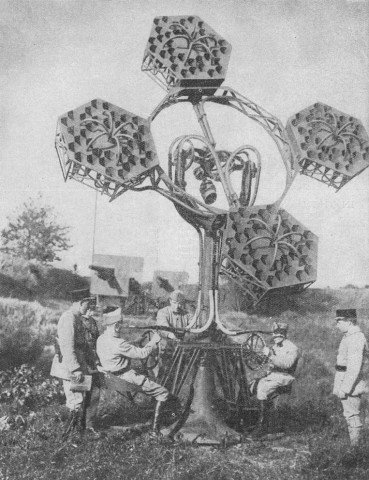


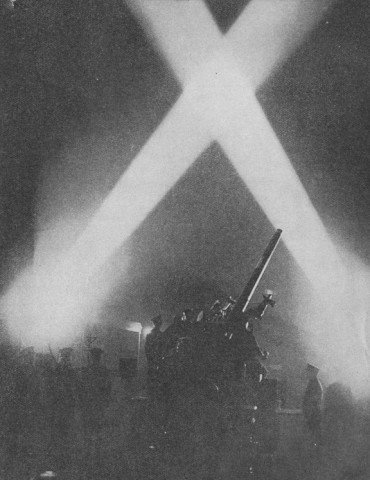
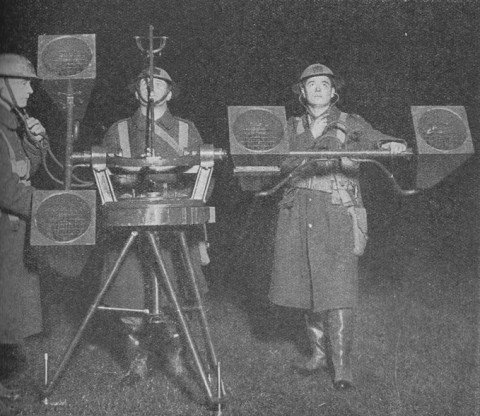

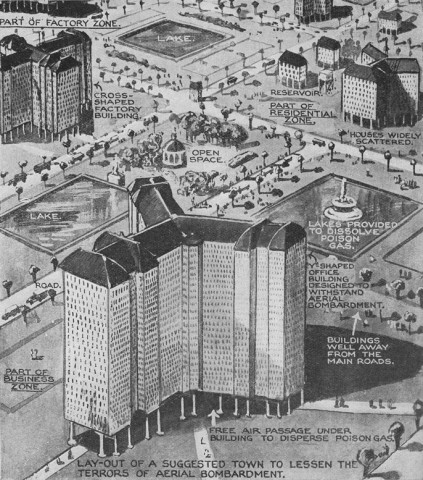

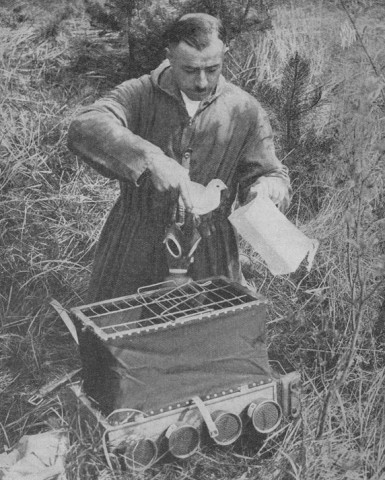
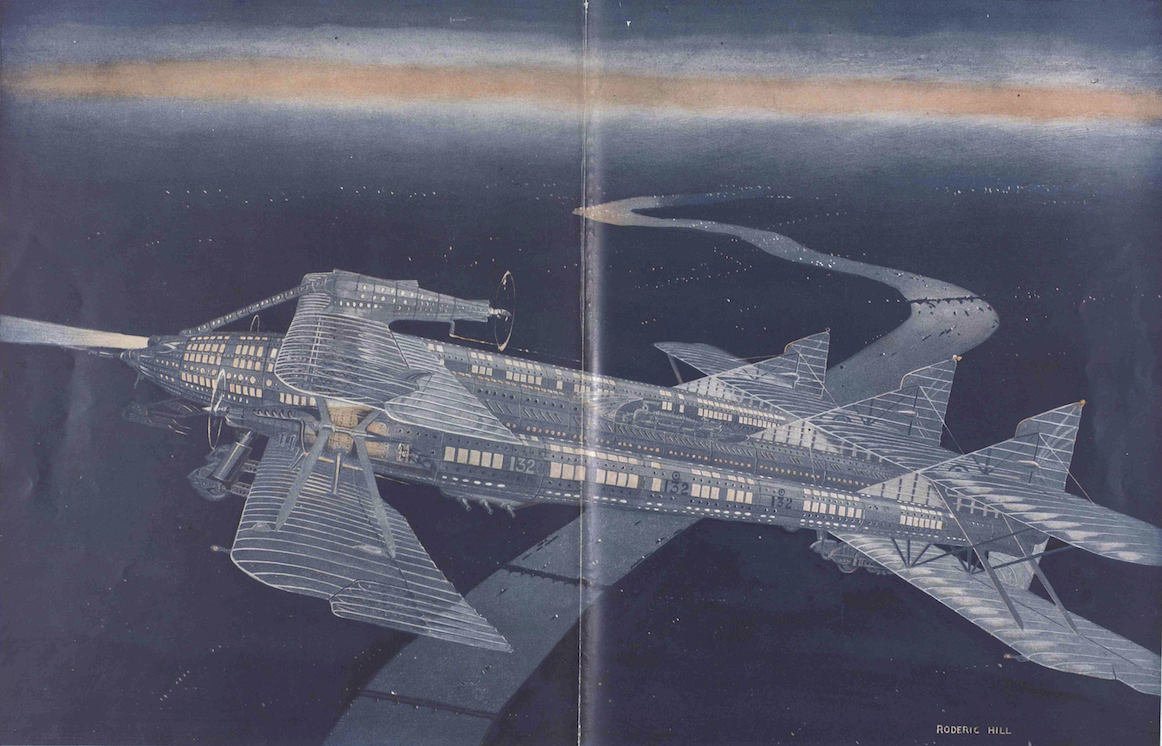

Pingback: Using sound for attack and defence | Transmissions from the Audient Void
Pingback: Gaming the knock-out blow — III | Airminded